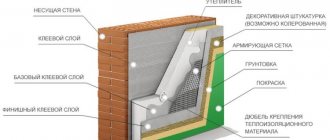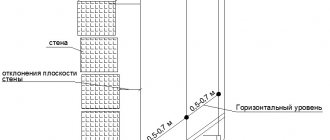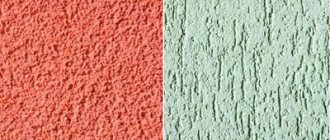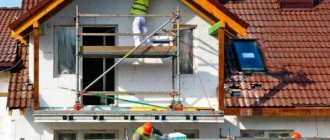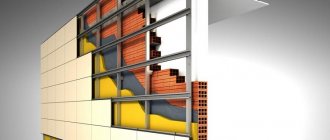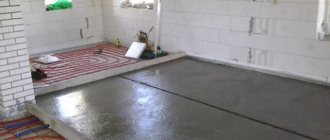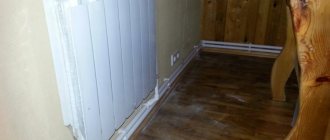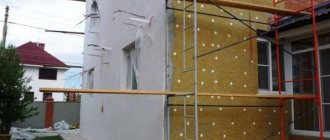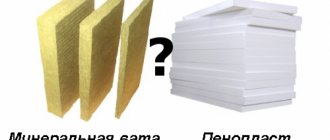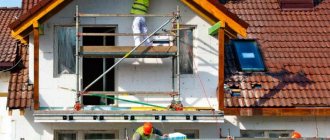The Ceresit wet façade system is a multilayer structure, which structurally consists of insulating boards fixed to the wall surface, reinforcing elements and a painted plaster layer. The most popular way to insulate buildings and premises is external wall insulation. And the technology that has deservedly taken first place among the methods of external insulation of building facades is the Ceresit insulation system.
The insulation can be polystyrene foam or mineral wool board. The reinforcing element is a plastic mesh. And the last plaster layer is the Ceresit building mixture. For painting, you can use paints based on acrylic, silicone, and silicates.
The main task of such insulation is to retain at least 1/3 of the heat during the cold season, and also, importantly, to give the facade of the house a pleasant appearance. Using this technology, the dew point is moved outside the room. That is why, even with a large difference in temperature inside and outside the house, condensation does not form.
Experts agree that the Ceresit wet facade technology deservedly occupies a leading position when choosing methods for finishing external facades. It 100% copes with the assigned tasks at relatively low costs for materials and labor, and helps to improve the operational characteristics of premises.
How to choose the right facade system for a wet facade depending on the wall material
| Facade | Systems based on polystyrene foam | Mineral wool based systems |
| Aerated concrete / foam concrete | No | Yes |
| Expanded clay concrete | Maybe | Yes |
| Monolithic reinforced concrete | Yes | Yes |
| Solid brick | Maybe | Yes |
| Hollow brick | No | Yes |
| Pine timber | No | Yes |
| Three-layer panel | Yes | Yes |
Do you want to order wet plaster of the facade?
The system installation technology will be followed 100% if you order its installation from our experienced specialists! We will create for you a reliable wet facade, the price per meter of which will pleasantly surprise you! The Ceresit wet facade system will be installed exactly on time! When the term “wet façade” is mentioned, the image of a façade abundantly moistened with water immediately appears in the imagination. But in fact, this method of finishing, of course, has nothing to do with such an association.
This phrase is just one of the attributes of figurative folk speech and cannot be found in textbooks. The question “what is a wet façade?” will be discussed in detail in the material below.
How to choose the right plaster for external walls
Experts say that if you choose the right façade plaster, it will last longer and caring for it will not require much effort. First of all, you need to assess the climatic conditions of the region where you live. For example, in rainy areas it is better to work with a silicone or acrylic finishing mixture - silicate and mineral masses are afraid of water. But the last two tolerate ultraviolet radiation well and do not fade in the sun. However, even for these species there is an unspoken law that discourages the use of too bright and too dark colors in areas with a predominance of aggressive sun. In the first case, burning will occur, and in the second, cracking, since the dark color attracts ultraviolet radiation too much.
For most areas of our country, elastic plaster will be the best choice. It perfectly repels moisture, allows air to pass through and contains special substances that prevent the appearance of fungus. Elastic facade plaster is used for any surface - from wood to concrete. It can last more than 30 years.
There are special compositions that are designed for certain materials of external walls. For example, ST-24 was created for walls made of cellular concrete. They cover aerated concrete, foam concrete, etc. For lightweight concrete, it can only be used to fill chips and cavities.
The correct choice of plaster is the key to long-term operation of the facade
What types of Ceresit plaster exist?
Facade plaster from the company Ceresit ct is divided into different types depending on the composition.
- Silicone. They are most often used for finishing walls. The composition prevents fungus from appearing over time and helps eliminate small cracks. Belongs to the category of expensive material.
- Acrylic. Allows you to remove defects on the surface of the walls. They do not have sufficient vapor permeability, but are distinguished by their smooth texture and strength.
- Cement. Due to the content of a sufficiently large amount of cement in the composition of the material, they are very durable and allow air to pass through well. They are very easy to apply. Cement mixtures are very elastic, which greatly simplifies the processing of walls and the time required for repairs.
- Silicate. The main substance in the material is silicate resin. Ready-made mixtures are very elastic and durable. In most cases, this plaster is used to treat indoor walls. Can be used in rooms with high humidity. Silicate Ceresite is less commonly used for exterior work if there is a wet facade.
- Mineral. It is customary to use it exclusively for external coating of building facades.
Variety of options
Also on sale are compositions intended for further coloring and coating without coloring. The Ceresit company offers mixtures that can be worked with at low temperatures – “winter” and at high temperatures – “summer”.
Textures of Ceresit plaster
Mixtures of this type have only two textured patterns. A certain texture can be obtained if the ceresit mixture contains special granules and by using a special application - “bark beetle”. This texture is applied in an extremely thin layer. The plaster contains many small grains, which make it possible to obtain an interesting pattern. Can be used for both interior and exterior work.
Each texture is available in different colors. If necessary, you can paint it yourself. It is best to use paints from the same manufacturer for this. It is worth noting that Ceresit paints may contain components such as acrylic, silicone or silicate.
Which insulation to choose?
When installing thermal insulation of facades, two types of insulation are mainly used - stone wool (other names for the same material are basalt wool, mineral slab, mineral wool) and unpressed facade polystyrene foam (PSB-S, PPS 16, PPS 15). Let's look at their main advantages and disadvantages.
Stone wool
| pros | Minuses |
| Flammability class NG, non-combustible material. Suitable for buildings of all fire resistance levels and fire hazard classes up to 100 meters. | Higher price compared to expanded polystyrene. |
| High vapor permeability. | Higher specific gravity compared to expanded polystyrene. |
| Suitable for all types of bases. | Restrictions on the use of protective and decorative coatings and paints (not suitable for acrylic materials) |
| High energy saving rates | Decrease in thermal insulation properties over time under the influence of dampness (accumulates moisture). |
| Possibility of use on curved sections of the building due to lamella slabs. | Red spots may appear. |
Facade expanded polystyrene
| pros | Minuses |
| Cheaper than stone wool. | Low coefficient of vapor permeability. |
| Easy to process (cut, grind) | Low sound insulation characteristics. |
| Lower labor intensity and, as a result, low cost of work (20-30% compared to stone wool). | Mandatory requirement for fire resistance (self-extinguishing property). |
| Any protective decorative coatings and paints can be used. | The flammability group G3-G4 imposes restrictions on use: they are mainly used in cottage low-rise housing construction. |
| Low weight of the insulation system, reducing the load on the building structure, saving on materials. | Afraid of UV radiation, not resistant to most organic solvents. |
| Ability to perform complex architectural forms. |
conclusions
- If it is necessary to ensure a high degree of fire resistance and fire hazard class K0, if the wall is made of vapor-permeable materials (light cellular concrete, brick, wood), then mineral wool will be the right choice.
- When insulating a private low-rise building, facade polystyrene foam is often used, which is cheaper, provides high thermal insulation, requires less labor, and opens up wide possibilities for facade design.
Installation of the Ceresit wet facade system
Installation of a ceresit wet facade is carried out in several stages, which include:
- preparatory work;
- installation of insulation;
- securing the reinforcing mesh;
- applying a plaster layer;
- surface painting.
High-quality performance of work at each stage is important for all subsequent ones and affects the final result.
Ceresit plaster insulation system - device sequence
Preparing the wall surface
Work on the installation of a facade system begins with an inspection of the surface of the walls on which the mounted materials will be fixed. At the same time, the outer surface is thoroughly cleaned of any dirt and carefully inspected. Defects in the form of cracks, irregularities, potholes are detected and, if necessary, eliminated.
In some cases, to improve the load-bearing capacity of the walls, they are covered with a rough layer of plaster. After this, the entire bearing surface is primed.
Preparing the wall for the construction of the facade requires special attention - the surface must be smooth
To reliably ensure the stability of the system, a U-shaped metal profile is fixed at the bottom of the wall, which plays the role of a support bar. This element is installed along the entire perimeter of the building, as well as above windows and doors. It protects the lower edge of the structure from moisture and allows the weight of the entire multilayer structure to be properly distributed.
The support profile is installed at a height of 30−40 cm from the ground level or installed on a protruding plinth. A gap of 3-4 mm is left between the individual slats to compensate for possible thermal expansion. For fastening, plastic dowels and screws are used, which are driven in every 15-20 cm.
Installation of insulation
Installing insulation is not a complicated process, but it is responsible
After completing the preparatory work, they begin to install the insulation. First, mineral wool boards or polystyrene are glued to the prepared surface using Ceresit SM-15 or SM-11 wet facade adhesive. The glue is applied with a notched trowel in the form of a wide strip along the entire perimeter of the slab and a dotted area in the center. This allows for reliable fastening of the material while economical use of adhesive. To do it correctly, it is enough to cover 40% of the surface of each slab with glue.
The slabs are installed from the bottom up, starting from the bottom row, which is immediately installed along the entire perimeter. Installation of each row starts from the corner. Wherein:
- vertical joints between slabs in adjacent rows should not coincide;
- adjacent slabs are pressed tightly against each other to minimize the thickness of the seams;
- Excess glue protruding from the seams is immediately removed.
Scheme of fastening the insulation with a disc dowel
Three days later, after the glue has completely dried, fastening plastic dowels are installed, the design of which includes a wide disc-shaped head, a plastic nail and an expanding nail to be driven in.
The length of the dowels used depends on the thickness of the insulation and the wall material. The penetration of a nail into a wall made of porous materials should be at least 9 cm, and for hard materials, at least 5 cm. 6-10 pieces are driven into each slab.
Installation of the reinforcing layer
Reinforcement begins no earlier than one day after installing the insulation. The material used for the reinforcing layer is a façade mesh made of fiberglass with a special alkali-resistant coating. Adjacent mesh strips should overlap each other by 5-8 cm. If it is necessary to strengthen individual sections, the mesh is applied in two layers. A special corner with an edge mesh is installed at corners, doorways, windows and lintels.
The reinforcing material is covered with a layer of adhesive composition 2-3 mm thick, and the total layer thickness can reach up to 5 mm.
The final stage of installing a “wet” Ceresit façade is finishing. It involves applying a layer of plaster to the surface and then painting it. You can begin this work only after the reinforcing layer has completely dried, which lasts 3-5 days.
The material for the plaster layer must have high vapor permeability, good resistance to adverse weather conditions and high mechanical strength. For this purpose, special dry facade mixtures Ceresit are used. Plastering work can be carried out in dry weather at an outside temperature of +5°C to +30°C, while direct sunlight is not allowed on the fresh plaster layer.
The surface is painted with a roller or through a spray bottle with acrylic, silicate or silicone Ceresit paints.
Installation technology
It is important to follow the installation technology in the exact sequence. The start of work is always preceded by the necessary surface preparation
It consists of assessing and constructing the foundation, preparing wooden or metal scaffolding.
Stage of preparation for installation of a “wet” facade
Inspect the base.
It needs to be freed from dirt.
Check the base for load-bearing and adhesive qualities.
If the finish is partially damaged, it is removed and entire sections are replaced. If there are irregularities on the facade, the surface is leveled with a plaster compound.
If the facade is finished with a material with a high degree of absorption, it must be carefully primed.
Old plaster is also removed if it is present on the surface of window and door slopes.
Base profile device
Now you need to install the profile strip.
This design allows you to distribute the load from the heat-insulating slabs that are planned to be laid in the future. The profile is also necessary to protect the bottom row of slabs from high humidity. The profile is fixed taking into account the following rules:
- The profile must be installed 40 cm from the ground surface.
Gaps of about 3 mm are left between the horizontal slats. It is necessary in case of thermal expansion. - The profile is secured with dowels and self-tapping screws
, the number of which is per 1 sq. m is determined depending on the mass of the insulating boards. Typically the step is from 10 to 20 cm.
A special angular profile is used at the corner joints
Installation of the thermal insulation layer
To organize a “wet” facade, insulation is traditionally used, represented by slabs of mineral wool or expanded polystyrene.
What is needed for proper installation of slabs?
You need to retreat 3 cm from the edge. Then glue is applied along its entire perimeter in a wide strip.
In the middle, the adhesive mixture should be applied pointwise. As a result, the glue should cover about 40% of the entire surface area
Note! If you decide to use lamella mats to insulate the facade, their surface must be completely covered with glue.
The slabs are laid staggered, as in the case of brickwork. Plates with insulation are pressed tightly against the wall surface and adjacent slabs. Excess glue is removed immediately during work.
The insulation is installed in rows. Start from the bottom of the base profile, gradually moving upward.
- If the walls of your house are made of solid material, the recess should be 5 cm.
If the walls are porous, the recess should be 9 cm. Keep in mind that per square meter. m there should be 6 - 14 dowels. But the exact quantity is determined by the mass and thickness of the insulating board, its location and the diameter of the fasteners. - First, nests are made, after which dowels are installed.
If top fastening is used, the clamping bushings are placed flush with the surface of the insulating layer.
Installation of the reinforcing layer
You can use its installation three days after installing the thermal insulation layer
. First you need to process the corner bevels on doorways and windows, the outer corners of the house and the joints on vertical slopes. And only after this can the smooth sections of the wall be processed.
Reinforcement is carried out according to this scheme:
- The glue is applied directly to the surface of the insulation. A reinforcing mesh consisting of fiberglass is slightly recessed into it.
- A covering layer is applied to it.
The resulting reinforcement thickness should be no more than 6 mm.
A mesh is placed at a distance of 2 mm from the surface.
Finishing stage
After a week, the reinforcement layer will dry completely
. A layer of plaster is applied on top of it. Use only plaster suitable for exterior use. The plaster composition must have an increased degree of vapor conductivity, resistance to precipitation and mechanical damage.
The quality of the resulting plaster surface is largely determined by the conditions under which it is applied to the surface. The optimal temperature ranges from +5 to +30 degrees
It is important that there is no strong wind or precipitation during this period.
There must be a shadow. If it does not exist, you will have to create it artificially.
Technology of working with plaster
In order for the material to be applied correctly, a special technology must be followed, which all professionals adhere to.
If the material is used for external covering, then the border that is located between the facade and the foundation must be covered with a special plinth profile.
A reinforcing layer, the thickness of which is 2-3 mm, must be applied. The reinforcing mesh is laid in such a way that it is completely buried in the mixture. Next, another reinforcing layer is applied to the mesh. The surface is left for some time until completely dry.
To finish with ceresit bark beetle plaster, you should follow these steps.
- The pre-prepared surface is treated with a primer so that the plaster adheres better to the wall.
- To work with Ceresit material, it is advisable to use a primer paint from the same company. It should have the same color as the topcoat.
- Decorative plaster is applied to the primer layer. The layer should be thin enough and not exceed the thickness of the grain used in the composition.
- The plaster should be applied in small sections, each of which should be carefully leveled.
- After the layer of decorative coating stops sticking, you can create the desired texture and pattern using a special polyurethane trowel.
How to create an invoice
The decorative coating can be rubbed in different ways, depending on what kind of pattern you want to get in the final result. For example, horizontal or vertical movements, circular. A polyurethane or plastic grater is used to create texture.
We create an invoice
Decorative plaster Ceresit allows you to make a building or premises more attractive in appearance. Due to the huge number of features and advantages, the material from this manufacturer is considered to be one of the best on the modern construction market.
A few words about application technology
The technology of applying the mixture using a trowel is considered a common cladding method. The solution applied to the wall surface is evenly distributed over the entire surface. The mixture is rubbed with a trowel in a circular motion. Depending on how you work with the tool, you will get a drawing of a certain shape. Do not put pressure on the trowel. The thickness of the masonry is determined by the fraction of pebbles.
The technology of applying the mixture using a trowel is considered a common cladding method. The solution applied to the wall surface is evenly distributed over the entire surface. The mixture is rubbed with a trowel in a circular motion. Depending on how you work with the tool, you will get a drawing of a certain shape. Do not put pressure on the trowel. The thickness of the masonry is determined by the fraction of pebbles.
If you want to use the ironing method, then after about 20 minutes of drying the first layer, apply the plaster a second time. In 10 minutes. It can be leveled and polished after 20 minutes.
If you have a roller, you can use it to create an unusual pattern by rolling the working mixture evenly over the wall after treating the surface with a trowel.
The technology of applying ceresit stone plaster using a spatula is a long and labor-intensive process. What is important here is the speed of applying the finished plaster solution over the entire surface of the wall before the mixture hardens. The mortar for plaster is prepared in such a way as to remove the entire workpiece before it hardens.
Conditions for carrying out facade work
The most important parameter is the period of work. There are temperature restrictions associated with the quality of the selected materials. All actions are performed at a temperature not lower than +5 degrees.
This factor influences both the quality of the work performed and the service life of wet facades. If the temperature regime is disturbed, the outer layer may crumble or crack.
The “wet facade” technology is interesting because it can be used to do the work yourself. But still, you will need some knowledge and skills for plastering.
Installation of abutment elements on blocks of window and door openings
During insulation, the insulation must extend at least 15-20mm onto the window frame to prevent a cold bridge. The abutment element with the mesh is glued to the window frame on three sides, top, right and left.
Technical characteristics of Ceresit plaster
Characteristics that are important for choosing when purchasing include the viability of the solution, the volume of water for mixing in liters, the mixture consumption per square meter with a layer thickness of 1 mm and the price in relation to packaging.
The viability of the solution depends on the composition and specialization of the solution, ranging from 60 to 120 minutes or more. This duration allows you to carry out finishing work without haste, apply an even layer and achieve the desired result that is pleasing to the eye.
The consumption of the mixture depends on the mixture and the grain size of the fraction. This aspect is better than many competitors. Thanks to the latest and favorable price-quality ratio, ceresite is one of the best solutions on the plaster market at the moment.
Sanding the insulation planes according to the three-meter rule
Sanding is done using a plywood grater measuring 400 x 600 mm, 500 x 700 mm with sandpaper glued to it with a coarse grain of 100 microns (1 mm). This sanding allows you to smooth out small irregularities that occurred when gluing the insulation due to initial deviations in the geometry of the glued sheets and due to errors during gluing. Small graters should absolutely not be used on large surfaces; small graters create unevenness and depressions when sanding.
List of materials for the Ceresit wet facade system
Installation can be carried out only after all materials have been selected for a complete transformation of the facade according to the Ceresit method. Several options for means with their own functional features are provided as part of the façade transformation.
Adhesive for facade reinforcement
Adhesive for foam reinforcement is an opportunity to impart strength to the insulation, thanks to which the finished “pie” of the facade will withstand mechanical loads, maintaining its durability and reliability.
Decorative “CERESIT DEKOR PLUS”
This is one of the many options for decorative plaster mixtures, which are designed specifically to achieve an original look. The material is provided in dry form, so you can count on quality and benefits due to the fact that the plaster can be diluted in the required quantity.
Silicate-silicone "Ceresit 174"
This is a decorative plaster called Lamb, which allows you to give the facade relief and a 3D effect, but it is important to apply the material correctly so that uniformity is formed in combination with the appearance
Heavy and light wet facade
Today there are two types of insulated wet facade: • heavy, • wet.
“Heavy” wet facade
A wet façade of this type does not involve gluing insulation to the wall. Dowels are inserted into the wall, and insulation is attached to them using special hooks. It is reinforced with a special mesh and pressure plates. This mesh is then plastered and covered with a finishing layer on top.
This technology allows the structure to absorb thermal and seismic deformations. Some builders call this design “floating insulation.”
For a heavy wet facade, a thick layer of plaster up to 40 mm is used. This is necessary in order to cover the metal mesh. At the same time, the wall must withstand heavy loads. A heavy wet facade is more expensive than a light one. This option is suitable for insulating walls in regions with harsh climates.
"Light" wet facade
This wet façade insulation system is used most often. Its cost is very low. At the same time, there is minimal load on the walls. Any surface can be used for light wet facade technology. The wall must be flat. If the masonry is made by hand, then before applying insulation, you need to plaster the wall.
The insulation is attached to the wall using dowels and glue containing cement. Solid mineral wool slabs are suitable as insulation. This material is non-flammable and allows air to pass through well. This is especially true for masonry.
Lightweight technology involves laying finishing layers on top of insulation. The thickness of the finishing plaster should be no more than 8 mm, ideally 4 mm.
What is the difference between insulation materials
Polystyrene foam, which can be installed on the facade of a building, sells for approximately 2000 rubles per m, and mineral wool costs approximately 2-2.5 times more. This feature is one of the most significant arguments when choosing materials for insulation. Polystyrene foam has several distinctive features that can be considered advantages. This material can be cut any way you like and sanded very easily, which creates even corners and a perfectly smooth surface. Foam plastic is easy to process and with its help it is very easy to install various cornices and projections on the building, giving the structure an original appearance.
- Wet façade using mineral wool
- Wet facade using foam plastic
If this material is so good, then why is mineral wool used? The high elasticity index makes it possible to cover internal and external curves on surfaces. Mineral wool will always be in close contact with the wall. The high sound insulation rate makes it possible to install a wet façade with such insulation on a building located close to a noisy highway. Mineral wool allows more steam to pass through it than polystyrene foam.
When a wet facade is designed, the size of the insulating layer is selected in such a way that moisture does not collect in the walls and the house remains warm. All efforts will be in vain if water vapor penetrates the wall from inside the building. Wet structures will always freeze strongly and such finishing will not last long in the future. To make the correct calculation of the material when designing a wet facade, you need to contact specialists, and it is first recommended to obtain the necessary data yourself, using one of the online calculators.
Types of thermal insulation systems depending on the insulation
Today there are two main options used for insulating facades:
- Heavy “wet” facade. When installing it, it is not supposed to glue insulation to the wall surface. Dowels are inserted into it, to which the insulation is attached. For this you will need special hooks. A special mesh is applied to the facade and plastered, after which it is covered with a finishing finish. The plaster layer should be thick enough and be about 40 mm. This option is more expensive, but it is best suited for insulating the facade in harsh weather conditions.
- Light “wet” façade. This type of system is used more often, since it provides minimal load and has a low cost. To install it you will need any flat surface. To install insulating boards, glue and cement are used. Additionally, you can use dowels. Slabs made of solid mineral wool are suitable for insulation. The final layer of plaster should be about 4 mm thick.
Reviews: advantages and disadvantages
Compared to other similar materials, Ceresit facade systems have a number of advantages:
- allow you to significantly reduce the consumption of building materials during the construction of a building without increasing heat loss during the cold season;
- give the building a beautiful appearance for a long time of the year;
- do not require serious financial expenses;
- have little weight.
At the same time, the low cost of materials and ease of installation make the façade of the Ceresit system quite affordable for the vast majority of developers.
Choosing insulation for the structure
The main purpose of a wet facade is to insulate buildings, so much attention is paid to choosing high-quality insulation. It must meet the following criteria:
- small weight;
- environmental friendliness, since the work is performed for a residential building;
- low water absorption rate;
- good resistance to mechanical stress;
- even with a sharp change in temperature, the material should not change its structure;
- installation must be simple and cost low.
Only some thermal insulation materials meet these requirements. These include:
- polystyrene foam - has a specific structure, which contains a huge number of closed air bubbles. It has low cost and is also easy to install. It has a small mass, so it does not affect the foundation and other parts of the structure. Resistant to mold or mildew growth. Its disadvantages include poor breathability. It is also not durable, so even minor mechanical impacts easily lead to its destruction. It is not advisable to use it for wooden buildings;
- expanded polystyrene is a modern type of polystyrene foam. In the process of creating a wet facade, preference is often given to polystyrene foam. Its structure also contains numerous closed air bubbles, so it has good thermal insulation parameters and does not allow moisture to pass through. It is resistant to fire and has a low mass. The material is considered unsuitable for wooden houses because it impairs their breathability;
- mineral wool - created using special fibers obtained by melting all kinds of rocks. The material is popular because it contains only natural and environmentally friendly components. Cotton wool is lightweight and affordable. The disadvantages include the lack of resistance to moisture, due to which mineral wool loses its thermal insulation parameters.
Mineral wool is most often chosen for wet facades. It is available in slabs that are easy to attach. To insulate a building using this material you will not need to spend a lot of money.
Foam plastic Expanded polystyrene Mineral wool
House insulation schemes
There are three schemes for thermal insulation of facades: a wall with insulation from the inside, a uniform wall of sufficient thickness, a wall with insulation from the outside (SFTK). Each has its own pros and cons.
Wall with insulation from the inside:
+ high thermal protection indicators;
— the walls partially freeze, resulting in accelerated destruction;
- loss of usable area.
Homogeneous wall:
+ high-quality sound insulation;
— low thermal protection, in some regions (for example, in Siberia) it is necessary to build walls of great thickness;
— high material consumption;
— the walls partially freeze, resulting in accelerated destruction;
- loss of usable area.
Wall with external insulation (SFTK):
+ high thermal protection;
+ low material consumption;
+ increasing the service life of the building (if calculated correctly, the dew point is in the insulation, plus the facade system takes on all weather loads, protecting the load-bearing structures of the building);
+ additional sound insulation.
What's better?
When comparing thermal insulation schemes, it becomes obvious that insulating the facade from the outside is the most effective technology. It provides high energy efficiency, saving money on heating in winter and air conditioning in summer. With external insulation of facades, the wear of the structure as a result of atmospheric and climatic influences is reduced - the insulation layer partially takes over them. The technology of external insulation has low material consumption and allows you to build houses with walls that are 7 times lighter than traditional walls made of brick and concrete.
Preparing the base
The so-called wet façade Ceresit before the device involves preliminary preparation of the surface:
- The previous facade cladding, if present, is assessed for stability and the degree of its adhesion to the walls and, if necessary, is removed.
- If necessary, the surfaces are leveled. For this purpose, façade putty Ceresit ST 29 is used, applied to walls pre-treated with the primer composition Ceresit ST 17.
- Next, on the border between the base and the main facade, a base profile is installed along the entire perimeter of the building.
Facade putty Ceresit for leveling facade walls
Conditions for carrying out facade work
The most important parameter is the period of work. There are temperature restrictions associated with the quality of the selected materials. All actions are performed at a temperature not lower than +5 degrees.
This factor influences both the quality of the work performed and the service life of wet facades. If the temperature regime is disturbed, the outer layer may crumble or crack.
The “wet facade” technology is interesting because it can be used to do the work yourself. But still, you will need some knowledge and skills for plastering.
Application of decorative plaster
The final stage of arrangement of the Ceresit wet facade is carried out according to the following rules:
- For better adhesion to the reinforcing layer, it must be primed. The façade paint Ceresit ST 16, which is close in color to the future façade plaster, is used as a primer solution. It is applied evenly with a brush in one go.
- If you plan to apply silicone or silicate plaster, then you should use Ceresit ST 15 and ST 15 silicon primers, respectively.
- Thin-layer plaster should be applied to the base evenly, to the thickness of the grain, using a trowel held at an angle. The façade plaster applied with Ceresit must be additionally smoothed.
- As soon as the plaster solution stops sticking to the tool, it must be given the necessary texture with a plastic float held in a horizontal position.
Grouting textured decorative plaster
Features of creating plaster surfaces with different textures
To create a plaster layer with a “bark beetle” texture, such Ceresit plaster mixtures as ST 35 and ST 75 with a grain diameter of 3.5 mm, and ST 73 with a grain of 2 mm in diameter are used.
To achieve the required texture, grouting is done with a plastic polisher using movements in one direction (usually vertical or horizontal) or in a circular motion.
Ceresit “bark beetle” plaster in various color and texture variations
To create “pebble” textures, Ceresit façade plaster ST 73, ST 75 and ST 137 with a grain diameter of 1.5 mm, as well as ST 137 with a grain size of 2.5 mm, is used. Grouting is also done using a plastic polisher.
In addition to the above, there are textures modeled using various tools and mosaic-type textures. For the former, Ceresit plasters of the ST 36 series are used, for the latter - ST 77 with different grain diameters.
So, we have figured out how, using various building mixtures of the Ceresit system, you can create a high-quality, warm and beautiful facade (see also what other finishing materials are available for facades). We hope that our recommendations will be helpful to you for monitoring the correctness of work performed by hired specialists or for professional finishing of the facade with your own hands.
Preparatory work before starting the installation of the system and strengthening the insulation
The installation of Ceresit facades involves the removal of the previous cladding if its stability is questionable and it has poor adhesion to the walls.
The wet facade system may require leveling before further work, during which you can use Ceresit ST 29 façade putty.
This composition must be applied to surfaces that are pre-treated; for this, a façade primer of the Ceresit ST 17 brand must be used.
Then, in the area of the border that connects the base and the facade, along the entire perimeter of the building, it is necessary to strengthen the base profile, which will determine the starting point for installing the insulation slabs.
Afterwards, a heat insulator must be strengthened onto the surface of the facades; they can be slabs of expanded polystyrene or mineral wool.
They are perfectly fixed on the walls with adhesive mixtures of the ST 85 or ST 190 brands, produced by the manufacturer Ceresit. You can also use ST 84 polyurethane glue, which is sold in cylinders.
The peculiarity of the technology at this stage is that an adhesive mixture should be applied to the surface of the polystyrene foam insulation board, and it is necessary to form a strip, the width of which should be 6 cm, while its height should be 2 cm.
The composition should be applied along the perimeter of the base, 2 cm away from the edges. The mixture should be applied in the central part of the slab like beacons, the diameter of each of which should be 10 cm and the height 2 cm.
The maximum number of such beacons should be 8 pieces.
If the insulation process is to be carried out using mineral wool slabs, then the adhesive mixture should be applied in a continuous layer. Once the glue has been applied and distributed, the slab can be applied to the wall and pressed. At the stage of strengthening the insulation, the Ceresit system should be built from the base profile; the material should be laid in order, moving upward.
Do not forget that during the installation of insulation, its position should be controlled using a level. Now you should wait until the glue hardens, only after, in order not to change the position of the plates occupied by them during the fastening process, you can grind the base using a polisher equipped with coarse sandpaper.
Then the insulation can be further strengthened, as described above.
Installation of the reinforcing layer
At the next stage of arranging Ceresit facades, a waterproofing mixture should be applied to the surface of the insulation; when using polystyrene foam heat insulator, the ST 85 mixture from Ceresit is used; when using mineral wool, the waterproofing mixture ST 190 is suitable. The mixture solution should be applied to the base in a layer of 3 mm.
The reinforcing mesh should be laid on the freshly applied mortar and recessed into it with a trowel. Arranging a wet facade requires laying a mesh with an overlap, which can vary from 5 to 10 cm.
During this process, the mesh does not need to be stretched too much and deepened all the way to the heat insulator. Then the façade system must be equipped with a layer of mortar, the thickness of which must be 2 mm.
The mixture should be applied so that the mesh is hidden underneath. And then the surface should be leveled using a metal grater.
Arrangement of the decorative layer
The process of insulating facades using the Ceresit system involves applying a finishing decorative layer at the last stage.
To ensure better adhesion of the reinforcing and decorative layers, priming should be done. As a primer solution, you can use ST 16 facade paint, the color of which is close to the color of the facade plaster. It should be applied as evenly as possible, using a brush; one layer will be enough.
When constructing a plaster facade using a silicone or silicate mixture, you should use a primer of the ST 15 silicon or ST 15 brand in tandem.
A thin-layer plaster mixture should be applied to the surface as evenly as possible, the thickness of the layer should be equal to the thickness of the grain, while using a trowel, the tool should be held at a slight angle, after which the surface must be further smoothed.
After the facade plaster stops sticking to the tool, it can be given the desired texture using a plastic trowel, which must be held in a horizontal position.
Types of plaster mixtures
Ceresit brand facade plaster is available with different types of binders. They differ in their properties and performance characteristics. When choosing one of the types, you need to take into account the operating conditions of the house, climate characteristics, wall material, and the possibility of obtaining the desired decorative effect.
Detailed information about each type can be obtained by examining the packaging. Dry mixtures are sold in bags; they must be diluted with water according to the instructions before use. The finished plaster is packaged in buckets; you just need to mix it:
- Mineral plasters Ceresit. Polymer-cement dry soluble mixtures for thin-layer finishing of facades ST137, ST35, ST36 are available pigmented and for painting. They are resistant to environmental influences, shocks, vapor permeable, environmentally neutral, and easy to apply. Designed for application to concrete, plastered brick bases, as well as for use in thermal insulation systems. They can have a texture (pebble, bark beetle or other), grain size from 1.5 to 3.5 mm.
- Acrylic Ceresit plasters are produced in ready-to-use form in buckets. Textured mixtures of bark beetles ST63, ST64 and stone ST60 with a grain size of 1 to 3 mm are applied to concrete, prepared brick, plastered walls. Not used for plinths. They are resistant to weather factors, impacts, have water-repellent properties, are elastic, and are easy to apply.
- Decorative mosaic polymer plaster ST77 with a grain size of 0.8 to 2 mm is used for surfaces that are exposed to moisture and frequent contamination (plinths, stairs, etc.). Resistant to friction, environmental influences, hydrophobic, easy to clean.
- Silicate plasters Ceresit ST72 (pebble) and ST73 (bark beetle) with a grain size of 1.5 to 3 mm have high vapor permeability, water-repellent properties, resistance to external influences and contamination, and are ready for use.
- Silicone plasters St74 (pebble) and ST75 (bark beetle) are characterized by high elasticity and vapor permeability. Resistant to pollution and external influences, hydrophobic, environmentally friendly. Apply to brick, concrete, plastered and gypsum bases.
- Silicone-silicate plasters ST174 (pebble) and ST175 (bark beetle) of the Ceresit brand have unique properties. With high vapor permeability and water-repellent properties, they are resistant to mold, algae and various contaminants, exposure to precipitation, and ultraviolet radiation.
Restoration plasters
Dry plaster mixture Ceresit ST26 and ST63 is used for restoration of internal and external surfaces, facades of historical buildings with low cladding strength. Also used on salted brick and concrete walls. It can be applied to both dry and wet surfaces.
Restoration plaster is vapor permeable, repels moisture, has minimal shrinkage, is easy to apply, and is environmentally friendly. When working, the necessary conditions must be observed - base temperature from 5 to 30 degrees and air humidity 50%.
Main advantages
Ceresit brand insulation materials work most effectively when combined. The system developers took into account the characteristics of various materials and made them as compatible as possible. The resulting solution was tested several times, after which it was released onto the market.
The result is that the consumer receives a system, each element of which is precisely verified and tested. The creators of the unique thermal protection did not forget about decorativeness: a wide selection of finishing materials allows you to insulate any building. Even historical buildings can be not only thermally insulated, but literally restored! After completion of the work, the structure looks like new.
The technology for insulating facades with the Ceresit system is a closed system with a layer of protective plaster on top of thermal insulation. The insulation is attached to the outside of the building with cement glue, and a thin protective layer reinforced with fiberglass mesh is created on its surface. Decorative finishing of the facade consists of thin plastering.
In this facade insulation system, two types of insulation are used - mineral wool (Ceresit WM) or expanded polystyrene (Ceresit VWS).
Step-by-step instruction
The Ceresit system is not complicated. However, its installation must strictly comply with the manufacturer’s established rules. Let's consider the stages of work.
Comprehensive base preparation
Insulation begins with an inspection of the facade itself, the roof structure and the base. The walls and basement area are checked for various damages, and any existing irregularities are eliminated.
Experts also study the general condition of the roof and cladding, including waterproofing coatings and the finishing façade layer. After the inspection, the nature and volume of contamination on the enclosing structures is determined. Any problems found should be fixed.
Installation of tile heat insulator
Installation of slabs begins from the corner of the structure. The first horizontal layer is placed on a perforated type profile element. The height of the belt around the perimeter is 25 cm, thickness is 4-8 cm. Products made of polystyrene foam are glued with Ceresit CT-85.
The slabs are installed three days after the building is prepared. Dowels equipped with cartridges and washers are used as fastening. Holes for doweling are drilled either with a hammer drill or a drill - the main thing is not to damage the surface of the previously installed slabs.
Waterproofing and reinforcement mesh
First, a waterproofing compound is applied, on top of which a reinforcing mesh is placed. The corners of the slabs are insulated with a perforated aluminum corner. The dimensions of the corners are 25*25*0.5 mm. In addition, it is necessary to strengthen the corners near windows, doors and convex ribs well. The profile is mounted in a fresh layer of composition, after which it is puttied with it.
Further work boils down to applying a reinforcing mesh to the adjacent wall to cover the profile, 10 cm in size. To glue the mesh, use “Ceresit CT-85” or “Ceresit CT-190”.
The thickness of the second waterproofing layer ranges from 1-1.5 mm. If the system involves underground insulation, then after creating this layer it is necessary to waterproof the underground areas using Ceresit materials of the CR, CP or BT group. As soon as they dry, the soil is filled back in.
Finishing work
The finishing layer, as well as additional fasteners, are applied three days after laying the insulation with waterproofing. First of all, it is necessary to prime the surface to be treated with Ceresit ST-16. After 3-6 hours, the structure is covered with one of the following decorative materials - Ceresite CT-35, CT-64, CT-36, CT-63, CT-137, CT-60.
Preparation of Ceresit CT-35 or CT-36 is carried out by mixing with water in a ratio of 1: 0.2-0.22. The ratio for Ceresit CT-137 is 1:0.17-0.22. The duration of action of Ceresit CT-35 or CT-36 is 1 hour, CT-137 – 1.5 hours.
When insulating with mineral wool, finishing materials must have good vapor permeability. Because of this, the finishing layer can only be made from polymer or mineral plasters. In the system they are represented by silicone compounds.
Downloads
| Henkel is the first and only company in Russia that has developed and approved an ORGANIZATION STANDARD for façade systems. ORGANIZATION STANDARD: STO 58239148-001-2006: EXTERNAL THERMAL INSULATION SYSTEMS FOR BUILDING WALLS WITH A FINISHING LAYER OF THIN-LAY PLASTER “CERESIT”: Materials for design and working drawings of components. Installation instructions. Technical descriptions / LIMITED LIABILITY COMPANY "HENKEL BAUTECHNIK". — 7th edition, expanded and revised. - Moscow, 2022. - 92 p., ill. Download STO in pdf format |
Creation of plaster facades with different textures
In order to obtain a layer based on plaster that will have a “bark beetle” texture, mixtures of grade ST 35 and ST 75 should be used, the grain diameter should be equal to 3.5 mm.
The composition of the ST 73 brand is also suitable; its grain should be equal to 2 mm in diameter. You can get the desired texture by rubbing the surface with a plastic polisher, which should be moved in one direction, as a rule, it is horizontal or vertical, less often circular.
To obtain “pebble” textures, you can purchase facade plaster of the ST 73, ST 75 or ST 137 brands, the grain diameter of which should be 1.5 mm.
A mixture of grade ST 137, the grain size of which is 2.5 mm, can also achieve a pebble effect. Grouting should be done using the same tool.
In addition to those described, you can create a mosaic-type texture; a mixture of ST 77, which has different grain diameters, is suitable for it. Silicate, acrylic or silicone paint from Ceresit will allow you to obtain a certain shade of the surface.
Application of quartz primer Ceresit ST 16
When the base reinforcing layer has completely dried, at least 72 hours after the last re-upholstery, you can begin applying the Ceresit ST 16 quartz primer. The Ceresit ST 16 primer is applied with a paint brush, a wide brush, or a flute. The primer can be white, not a tinted base, or it can be painted to match the color of the future Ceresit decorative plaster.
